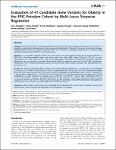Evaluation of 41 Candidate Gene Variants for Obesity in the EPIC-Potsdam Cohort by Multi-Locus Stepwise Regression
Knüppel, Sven
Rohde, Klaus
Meidtner, Karina
Drogan, Dagmar
Holzhütter, Hermann-Georg
Boeing, Heiner
Fisher, Eva
Objective: Obesity has become a leading preventable cause of morbidity and mortality in many parts of the world. It is thought to originate from multiple genetic and environmental determinants. The aim of the current study was to introduce haplotype-based multi-locus stepwise regression (MSR) as a method to investigate combinations of unlinked single nucleotide polymorphisms (SNPs) for obesity phenotypes. Methods: In 2,122 healthy randomly selected men and women of the EPIC-Potsdam cohort, the association between 41 SNPs from 18 obesity-candidate genes and either body mass index (BMI, mean = 25.9 kg/m2, SD = 4.1) or waist circumference (WC, mean = 85.2 cm, SD = 12.6) was assessed. Single SNP analyses were done by using linear regression adjusted for age, sex, and other covariates. Subsequently, MSR was applied to search for the ‘best’ SNP combinations. Combinations were selected according to specific AICc and p-value criteria. Model uncertainty was accounted for by a permutation test. Results: The strongest single SNP effects on BMI were found for TBC1D1 rs637797 (β = −0.33, SE = 0.13), FTO rs9939609 (β = 0.28, SE = 0.13), MC4R rs17700144 (β = 0.41, SE = 0.15), and MC4R rs10871777 (β = 0.34, SE = 0.14). All these SNPs showed similar effects on waist circumference. The two ‘best’ six-SNP combinations for BMI (global p-value = 3.45⋅10–6 and 6.82⋅10–6) showed effects ranging from −1.70 (SE = 0.34) to 0.74 kg/m2 (SE = 0.21) per allele combination. We selected two six-SNP combinations on waist circumference (global p-value = 7.80⋅10–6 and 9.76⋅10–6) with an allele combination effect of −2.96 cm (SE = 0.76) at maximum. Additional adjustment for BMI revealed 15 three-SNP combinations (global p-values ranged from 3.09⋅10–4 to 1.02⋅10–2). However, after carrying out the permutation test all SNP combinations lost significance indicating that the statistical associations might have occurred by chance. Conclusion: MSR provides a tool to search for risk-related SNP combinations of common traits or diseases. However, the search process does not always find meaningful SNP combinations in a dataset.
Dateien zu dieser Publikation
Keine Lizenzangabe
Verwandte Publikationen
Anzeige der Publikationen mit ähnlichem Titel, Autor, Urheber und Thema.
-
2007-05-25ZeitschriftenartikelFepA- and TonB-dependent bacteriophage H8: receptor binding and genomic sequence. Rabsch, Wolfgang; Ma, Li; Wiley, Graham; Najar, Fares Z.; Kaserer, Wallace; Schuerch, Daniel W.; Klebba, Joseph E.; Roe, Bruce A.; Gomez, Jenny A. Laverde; Schallmey, Marcus; Newton, Salete M. C.; Klebba, Phillip E.H8 is derived from a collection of Salmonella enterica serotype Enteritidis bacteriophage. Its morphology and genomic structure closely resemble those of bacteriophage T5 in the family Siphoviridae. H8 infected S. enterica ...
-
2005-06-20ZeitschriftenartikelViral promoters can initiate expression of toxin genes introduced into Escherichia coli Lewin, Astrid; Mayer, Martin; Chusainow, Janet; Jacob, Daniela; Appel, BerndBackground: The expression of recombinant proteins in eukaryotic cells requires the fusion of the coding region to a promoter functional in the eukaryotic cell line. Viral promoters are very often used for this purpose. ...
-
2013-08-08ZeitschriftenartikelCytomegalovirus Downregulates IRE1 to Repress the Unfolded Protein Response Stahl, Sebastian; Burkhart, Julia M.; Hinte, Florian; Tirosh, Boaz; Mohr, Hermine; Zahedi, René P.; Sickmann, Albert; Ruzsics, Zsolt; Budt, Matthias; Brune, WolframDuring viral infection, a massive demand for viral glycoproteins can overwhelm the capacity of the protein folding and quality control machinery, leading to an accumulation of unfolded proteins in the endoplasmic reticulum ...

